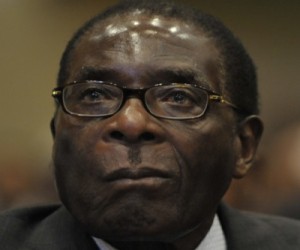 President Robert Mugabe
President Robert Mugabe
Revenues from the high mining taxes Zimbabwe charges to miners
—particularly to diamond producers— are nowhere to be found, said
Wednesday a cross–party mines and energy portfolio parliamentary
committee.
As reported by The Telegraph, the team found "serious discrepancies" between what diamond companies claimed to have paid in local taxes, and what the government said it had received.
When attempting to visit the country’s Marange fields, estimated to hold more than 25% of the world's diamond stocks, committee members said government officials and security agents repeatedly prevented them from accessing the area.
The group report, not the first one to suggest mining taxes in Zimbabwe are going to private pockets, fuels international fears that mining royalties are actively financing Robert Mugabe’s Zanu PF party campaign and intimidation of voters during the forthcoming elections.
“Over the last decade, elections in Zimbabwe have been associated with the brutal intimidation of voters. Orchestrating this kind of violence costs a lot of money. As the country approaches another election there is a very high risk of Zanu PF hardliners employing these tactics once more and using Marange diamonds to foot the bill. The Kimberley Process’s refusal to confront this reality is an outrage,” said in late 2011 Charmian Gooch, a Founding Director of Global Witness, when explaining the reasons he was quitting the Kimberly Process.
“It has become an accomplice to diamond laundering – whereby dirty diamonds are mixed in with clean gems. In a shocking move, the Kimberley Process recently authorised exports from two companies operating in the controversial Marange diamond fields in Zimbabwe. The Zimbabwean army seized control of the area in 2008, killing around 200 miners.
"Mining concessions were then granted in legally questionable circumstances to several companies, some of them associated with senior figures in Robert Mugabe’s Zanu PF party. Newspapers have reported that the Zimbabwean Central Intelligence Organisation, the state security service aligned with Mugabe whose members are accused of committing acts of violence against opposition supporters, directly benefits from off-budget diamond revenues.
“Over the last decade, elections in Zimbabwe have been associated with the brutal intimidation of voters. Orchestrating this kind of violence costs a lot of money. As the country approaches another election there is a very high risk of Zanu PF hardliners employing these tactics once more and using Marange diamonds to foot the bill. The Kimberley Process’s refusal to confront this reality is an outrage,” said Gooch in his official statement.
Last year, Zimbabwe’s Deputy Mines Minister, Gift Chimanikire, confirmed an army-owned company holds a 40% stake on Anjin, one of the most lucrative diamond concessions in the country.
Days later it was reported that a Chinese diamond mogul have ploughed $100 million into the African country’s Central Intelligence Organisation (CIO) to fund covert operations against the opposition.
Zimbabwe's diamond production from Marange increased from 8,7 million carats in 2011 to 12 million carats last year. This year, production is expected to rise further reaching over 17 million carats.
As reported by The Telegraph, the team found "serious discrepancies" between what diamond companies claimed to have paid in local taxes, and what the government said it had received.
When attempting to visit the country’s Marange fields, estimated to hold more than 25% of the world's diamond stocks, committee members said government officials and security agents repeatedly prevented them from accessing the area.
The group report, not the first one to suggest mining taxes in Zimbabwe are going to private pockets, fuels international fears that mining royalties are actively financing Robert Mugabe’s Zanu PF party campaign and intimidation of voters during the forthcoming elections.
“Over the last decade, elections in Zimbabwe have been associated with the brutal intimidation of voters. Orchestrating this kind of violence costs a lot of money. As the country approaches another election there is a very high risk of Zanu PF hardliners employing these tactics once more and using Marange diamonds to foot the bill. The Kimberley Process’s refusal to confront this reality is an outrage,” said in late 2011 Charmian Gooch, a Founding Director of Global Witness, when explaining the reasons he was quitting the Kimberly Process.
“It has become an accomplice to diamond laundering – whereby dirty diamonds are mixed in with clean gems. In a shocking move, the Kimberley Process recently authorised exports from two companies operating in the controversial Marange diamond fields in Zimbabwe. The Zimbabwean army seized control of the area in 2008, killing around 200 miners.
"Mining concessions were then granted in legally questionable circumstances to several companies, some of them associated with senior figures in Robert Mugabe’s Zanu PF party. Newspapers have reported that the Zimbabwean Central Intelligence Organisation, the state security service aligned with Mugabe whose members are accused of committing acts of violence against opposition supporters, directly benefits from off-budget diamond revenues.
“Over the last decade, elections in Zimbabwe have been associated with the brutal intimidation of voters. Orchestrating this kind of violence costs a lot of money. As the country approaches another election there is a very high risk of Zanu PF hardliners employing these tactics once more and using Marange diamonds to foot the bill. The Kimberley Process’s refusal to confront this reality is an outrage,” said Gooch in his official statement.
Last year, Zimbabwe’s Deputy Mines Minister, Gift Chimanikire, confirmed an army-owned company holds a 40% stake on Anjin, one of the most lucrative diamond concessions in the country.
Days later it was reported that a Chinese diamond mogul have ploughed $100 million into the African country’s Central Intelligence Organisation (CIO) to fund covert operations against the opposition.
Zimbabwe's diamond production from Marange increased from 8,7 million carats in 2011 to 12 million carats last year. This year, production is expected to rise further reaching over 17 million carats.

No comments:
Post a Comment
Note: Only a member of this blog may post a comment.